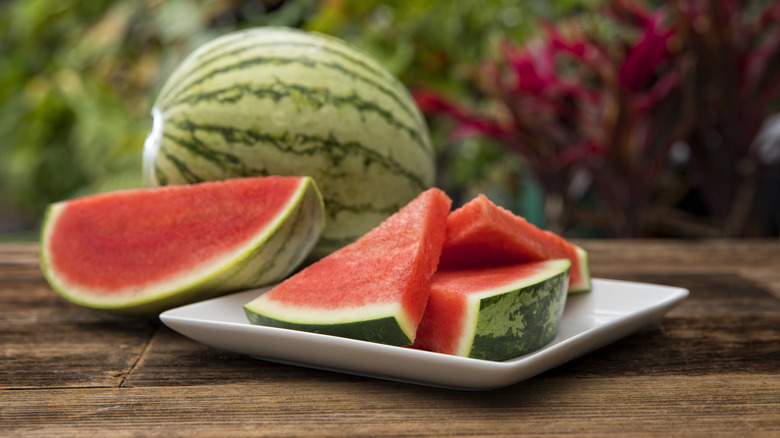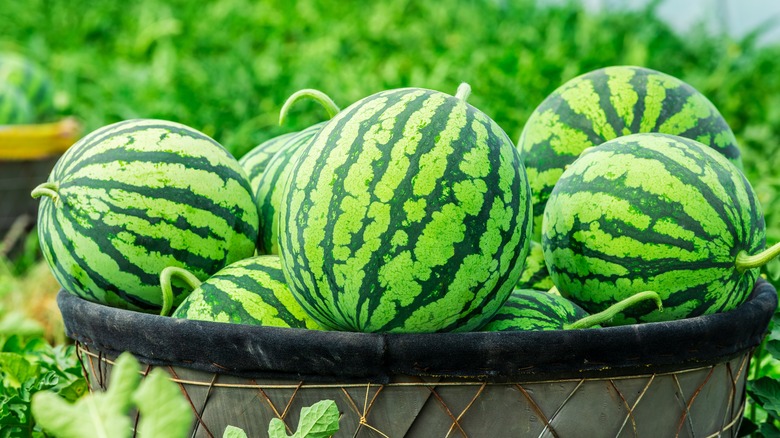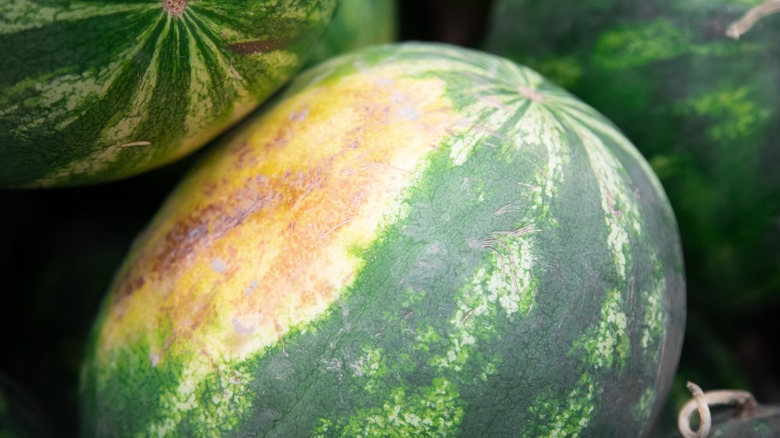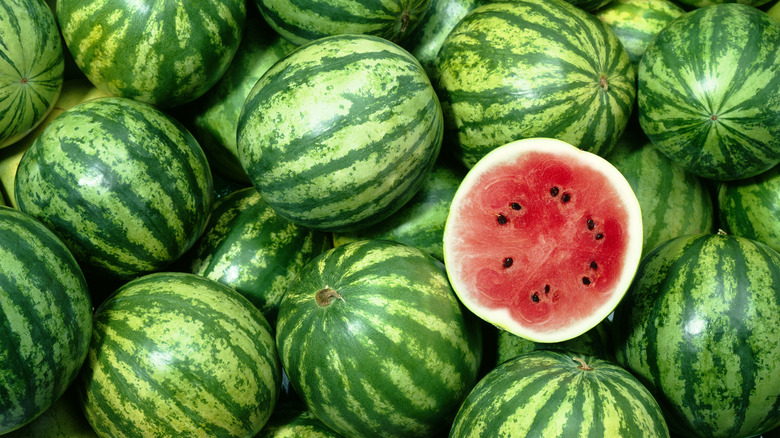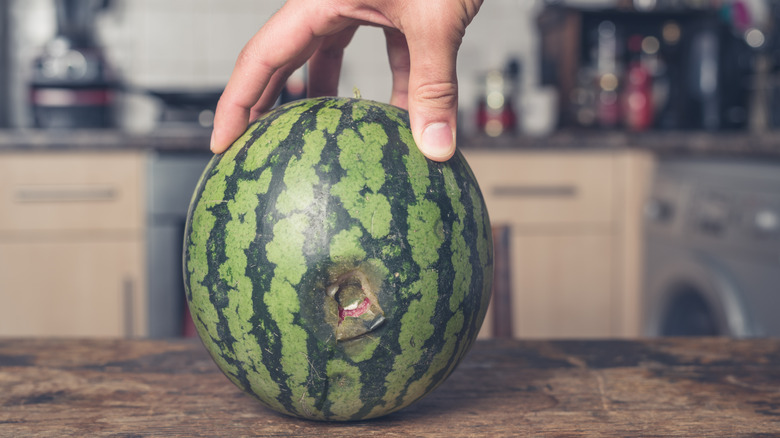What You Need To Know To Choose The Tastiest Watermelon At The Store
Summertime means hot days and cool refreshments, and there's no food more refreshing than watermelon. Don't even think about whipping up a 4th of July fruit salad without it. There's something special about sitting in the warm sun with streams of watermelon juice dripping down your chin. Beyond its delicious nature, watermelon is also a surprisingly nutrient-dense food, packed with antioxidants. It's the perfect warm-weather snack, but only if it's good and ripe.
A ripe watermelon is juicy and sweet, but of course, you can't experience that unless you cut into it and try a bit, something that grocery stores most certainly do not welcome. You'll have to go off of other signs, and that starts by knowing when to buy watermelon. In the U.S., watermelon season peaks between May and August, so that's the best time to buy one. You'll typically see them in a massive pile like Halloween pumpkins, so you'll have to dig around a bit to find a good one.
Judging any fruit based on its exterior characteristics can feel like a gamble, and you can never guarantee perfection. However, by using your eyes and ears to pick up subtle variations between melons, you can be pretty confident in finding the right one. Size, shape, texture, and color can all be used to judge a watermelon, and it's best to start by looking at the basics.
Start by checking the weight and shape
When you're picking through that pile of watermelons at the grocery store, the first characteristics you can use to separate the good ones from the duds are weight and shape. A ripe watermelon should have some serious mass to it. You want to find a watermelon that feels much heavier than it looks. This is an indicator that the melon is saturated with sweet juice.
In terms of shape, watermelons may be round or oval depending on the variety, so that doesn't matter. What you should be looking for is symmetry. You want to get a watermelon that is uniform on all sides. If one side of the melon is larger or plumper than the other, it's an indication that the melon wasn't watered evenly while it grew. It could also mean that the melon wasn't properly pollinated, which is a particularly common problem for seedless watermelons.
You also want the melon to have a smooth, uniform surface. Lumpy melons may be discolored on the inside, and if it has gashes or dents on the surface, that could mean the fruit has been penetrated by pests or fungi. The melon should not be pointy at the ends either, as that is a sign of under-ripeness.
Examine the melon rind closely
A fully-ripe watermelon should have a dark green, matte surface. On the top of the melon, you can see the remains of the stem that once held it to the vine. This is known as a tendril or tail, and it should be completely dry and brown. If the tail is green, that means the melon was cut from the vine before it had time to ripen.
On the bottom of the melon, you should see a patch of yellow skin. This is called a field spot, and it is the most important feature to look for in judging a watermelon. When a watermelon is ripe, its weight will cause it to hang down and rest on the ground. The part of the rind touching the ground will gradually change color to a dark yellow or orange hue. When you see this, it means that the watermelon spent a long time on the vine in order to fully ripen. If there is no field spot, or the field spot is white, it means that the melon was cut from the vine prematurely.
Lastly, look for patches of crisscrossed scratches on the melon. This is called webbing. It's well-known for being one of the key signs that cantaloupe is ripe, and while it isn't always as prominent in watermelons, it's still an important sign. These scratches are scars from pollinators, and more webbing means the fruit is likely sweeter.
Give it a thump
You can also use your ears to check the quality of a watermelon via the thump test. The thump test is simple: just pick up the melon, hold it close to your ear, and knock on the sides of it. If tapping the melon produces a low, hollow sound, that indicates that it is ripe. If the melon produces a higher-pitched tapping sound, that means it has not had time to fully ripen.
The thump test is a very popular way to inspect watermelons for ripeness, but it might be the least effective method you can use. The sound difference between a ripe watermelon and an unripe one can be very subtle and thus difficult to perceive. It is also subjective to some degree, as each person's idea of what a thump versus a tapping sound could vary. Looking at the field spot test might be a better approach.
How to identify a bad watermelon
When trying to identify a good watermelon, it helps to know what characteristics you should avoid. A white field spot, lack of field spot, uneven surface, and high-pitched sound are all important signs to look for, but there are other indicators that can help you identify overripe or rotting watermelons. When you're searching for a melon, you should press around the rind to see how firm it is. The rind should be thick and firm to your touch. If there is any give to the rind when you touch it, that's a sign that the watermelon is overripe. Overripe melons lose their sweetness and take on an unpleasant texture that is both mealy and slimy.
Checking the outside of a watermelon can reveal signs of spoilage or pests. Of course, any signs of mold growth on the melon should be a red flag. You should also give the melon a quick whiff to check for a sour smell, which could mean the flesh is fermenting. Lastly, check for light brown patches on the surface of the melon. These are signs that insects have been feeding on the fruit, and you'll be in for a nasty surprise when you cut your watermelon.
